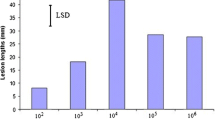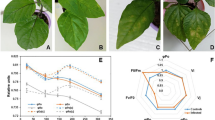Abstract
The impact of ozone in predisposingPhaseolus vulgaris toBotrytis cinerea has been investigated. One day after 8 h exposures to 0, 120, 180 and 270 μg ozone m−3, primary and trifoliate leaves of four bean cultivars were detached and inoculated with conidia suspended in water or in an inorganic phosphate (Pi) solution. Visible ozone injury increased with increasing ozone concentrations in all cultivars. Primary leaves were more sensitive than trifoliate leaves. Conidia suspended in Pi solution caused lesions on healthy leaves, whereas conidia in water did not. Ozone-injured leaves of all cultivars showed lesions byB. cinerea after inoculations in water. The number of lesions was significantly correlated with ozone injury for primary leaves. After Pi inoculations, the number of lesions on the ozone-sensitive cultivars also increased with increasing ozone concentrations. However, the ozone-tolerant cultivar Groffy showed first a decrease in the Pistimulated infection at the lowest ozone dosages. The trifoliate leaves of all cultivars were less predisposed to the fungus than the primary leaves. The results indicate that realistic concentrations of ozone enhance the predisposition of bean leaves toB. cinerea. The rate of enhancement depends on the level of ozone-induced injury which was influenced by cultivar, leaf and ozone concentrations.
Samenvatting
De invloed van ozon op de vatbaarheid van boon voorBotrytis cinerea werd onderzocht. Een dag na de blootstelling van vier bonecultivars gedurende 8 uur aan 0, 120, 180 en 260 μg ozon m−3, werden primaire en drietallige bladeren geïnoculeerd met conidiën in water of in een anorganische fosfaatoplossing (Pi). Zichtbare beschadiging door ozon nam met de concentratie toe in alle cultivars. De primaire bladeren waren gevoeliger dan de drietallige. In tegenstelling tot conidiën in water, verooraakten conidiën in de Pi-oplossing lesies op gezonde bladeren. Bij ozonbeschadiging vertoonden bladeren van alle cultivars lesies doorB. cinerea na inoculatie in water. Voor primaire bladeren was het aantal lesies significant gecorreleard met de bladbeschadiging. Na Pi-inoculatie nam bij de ozongevoelige cultivars het aantal lesies ook toe met de concentratie ozon. Echter, de ozontolerante cultivar Groffy vertoonde eerst een afname in de door Pi gestimuleerde infectie bij de laagste ozonconcentratie. De door ozon verhoogde vatbaarheid van drietallige bladeren was minder dan die van primaire bladeren. De resultaten tonen aan dat realistische concentraties van ozon boon vatbaarder maken voorB. cinerea. Deze stijging in vatbaarheid is afhankelijk van het niveau van de ozonbeschadiging die wordt beïnvloed door cultivar, soort blad en ozonconcentratie.
Similar content being viewed by others
References
Blakeman, J.P., 1980. Behaviour of conidia on aerial plant surfaces. In: Coley-Smith, J.R., Verhoeff, K. & Jarvis, W.R. (Eds) The biology ofBotrytis. Academic Press, New York, London, p. 115–152.
Eerden, L.J., van der, Tonneijck, A.E.G. & Wijnands, J.H.M., 1988. Crop loss due to air pollution in the Netherlands. Environmental Pollution 53: 365–376.
Fehrmann, H., Tiedemann, A., von & Fabian, P., 1986. Predisposition of wheat and barley to fungal leaf attack by preinoculative treatment with ozone and sulphur dioxide. Zeitschrift für Pflanzenkrankheiten und Pflanzenschutz 93: 313–318.
Heagle, A.S., 1982. Interactionsbetween air pollutants and parasitic plant diseases. In: Unsworth, M.H., & Ormrod, D.P. (Eds), Effects of gaseous air pollutants in agriculture and horticulture. Butterworths, London, p. 333–348.
Hofstra, C. & Ormrod, D.P., 1977. Ozone and sulphur dioxide interaction in white bean and soybean. Canadian Journal of Plant Science 57:1193–1198.
Krause, C.R. & Weidensaul, T.C., 1978. Effects of ozone on the sporulation, germination and pathogenicity ofBotrytis cinerea. Phytopathology 68:195–198.
Krupa, V. & Manning, W.J., 1988. Atmospheric ozone: formation and effects on vegetation, Enviromental Pollution 50:101–137.
Kuć, J., 1987. Plant immunization and its applicability for disease control. In: Chet, I., (Ed.), Innovative approaches to plant disease control. John Wiley & Sons, New York, Chichester, Brisbane, Toronto, Singapore, p. 255–274.
Kvist, K., 1986. Fungal pathogens interacting with air pollutans in agricultural crop production. In: Directorate-General for Science, Research and Development Environment Research Programme of the Commission of the European Communities (Ed.) How are the effects of air pollutants on agricultural crops in influenced by the interaction with other limiting factors? Proceedings Workshop at Riso National Laboratory, Denmark 23–25 March 1986, p. 67–78.
Last, F.T. & Hamley, R.E., 1956. A local-lesion technique for measuring the infectivity of conidia ofBotrytis fabae Sardiña. Annals of Applied Biology 44:410–418.
Leone, G. & Tonneijck, A.E.G., 1990. A rapid procedure for screening the resistance of bean cultivars (Phaseolus vulgaris L.) toBotrytis cinerea andSclerotinia sclerotiorum. Euphytica, in press.
Manning, W.J., 1976, The influence of ozone on plant surface microfloras. In: Dickinson, C.H., & Preace, T.C. (Eds), Microbiology of aerial plant surfaces. Academic Press. New York, London, p. 159–172.
Manning, W.J., Feder, W.A., Perkins, I. & Glickman, M., 1969. Ozone injury and infection of potato leaves byBotrytis cinerea. Plant Disease Reporter 53:691–693.
Manning, W.J., Feder, W.A., & Perkins, I., 1970. Ozone injury increases infections on geranium leaves byBotrytis cinerea. Phytopathology 60:669–670.
Mansfield, J.W., 1980. Mechanisms of resistance toBotrytis. In: Coley-Smith, J.R., Verhoeff, K. & Jarvis, W.R. (Eds), The biology ofBotrytis. Academic Press, New York, London, p. 181–218.
McCullagh, P. & Nelder, J.A., 1983. Generalized linear models. University Press, Cambridge.
Rist, D.L. & Lorbeer, J.W., 1984a. Moderate dosages of ozone enhance infection of onion leaves byBotrytis cinerea but not byBotrytis squamosa. Phytopathology 74:761–767.
Rist, D.L. & Lorbeer, J.W., 1984b. Ozone-enhanced leaching of onion foliage in relation to lesion production byBotrytis cinerea. Phytopathology 74:1217–1220.
Slooff, W., Aalst, R.M. van, Heijna-Merkus, E. & Thomas, R., 1989. Integrated criteria document ozone. Report no. 75847400, National Institute of Public Health and Environmental Protection, Bilthove, the Netherlands.
Tonneijck, A.E.G., 1983. Foliar injury responses of 24 bean cultivars (Phaseolus vulgaris) to various concentrations of ozone. Netherlands Journal of Plant Pathology 89:99–104.
Tonneijck, A.E.G., 1989. Evaluation of ozone effects on vegetation in the Netherlands, In: Schneider, T., Lee, S.D., Wolters, G.J.R. & Grant, L.D. (Eds.), Atmospheric ozone research and its policy implications. Elsevier Science Publishers B.V., Amsterdam, p. 251–260.
Author information
Authors and Affiliations
Rights and permissions
About this article
Cite this article
Leone, G., Tonneijck, A.E.G. Acute ozone exposure predispose Phaseolus vulgaris beans to botrytis cinerea. Netherlands Journal of Plant Pathology 96, 65–74 (1990). https://doi.org/10.1007/BF02005130
Accepted:
Issue Date:
DOI: https://doi.org/10.1007/BF02005130




